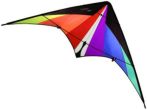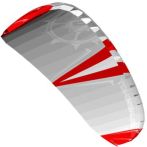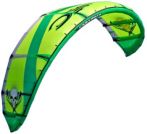Land vs. Water vs. Snow
Land / Water / Snow
So many choices, so little time.
MACkite Kiteboarding has been power kiting since 1985 and became a certified kiteboarding school in the spring of 2000. During this time we have seen everything from kiteboards, land boards, and roller blades to buggies with chains on the wheels for snow.
Here is a comparison of the different options available to people in the many uses of traction kites. You will notice that kiteboarding on the water is the hardest of all traction kites to learn. Spend your off season or bad wind direction days on a landboard, rollerblades or in the snow, and your on-the-water time will also grow as your skills as a rider increase.
Basic Types of Kites:

Framed kites
These are commonly referred to as stunt or sport kites. They are usually flown with 2 handles or straps and do not have a bar. Framed kites work well for smaller people and kids for most land activities. Vehicles with the least friction like ice skates, roller blades and skateboards can be pulled at high speeds using these kites. Framed kites can also be considered a trainer. Put a small bar (piece of thick dowel) in place of the handles and away you go.

Foil Kites
These kites are optimal for all land applications. There are 3 types of foils that range in size from .5 square meter to 18 square meters.
- 2 Line Foil - your simplest foil. This kite is great to learn on and works well most of the time. The major drawback is there may be no safety release and you cannot reverse launch the kite while riding.
- 3 or 4 Line Foils - These kites are great to learn on and work well for all applications of land or snow kiting. These kites have emergency safety systems to kill the kite's power. They can also be reverse launched when crashed during riding. You will spend a few bucks more, but save yourself a ton of walking to re-launch your kite.
- 4 Line Sheetable Foils - These are the performance kites of the foil line. There are 4 major advantages to sheetable foils.
- Safety - these foils are designed to be safe even when hooked into your harness.
- Re-launch - these foils are quick and easy to launch and re-launch.
- Gusty riding - sheetable foils allow you to add or subtract power as you ride. You won't get pulled over your edge when that strong gust comes through.
- Wind range - one sheetable foil is equal to 2 standard foils in wind range. Though you will pay much more, you will be getting two kites for the price of one.

Leading Edge Inflatable Kites or LEI's
These kites are optimum for water and snow riding. We don't recommend them for ground use. All modern LEI kites come with 4 or 5 lines, bar and safety systems. The float on the water and can be water re-launched, thus making them the best kite for the water. They fly very well and work on the snow, but do need to be pumped up with air and are not as durable as foil kites in the snow.
Vehicle Comparison Chart
Always take safety into consideration first and use this chart as a guide to help you make good decisions. The chart works with the assumption that you have flown a trainer.
| Number of Sessions * | ||||||||
| Vehicle | Ease of Learning | Amount of Power Needed | Standing Up | Able to Plane | Basic Vehicle Control | Riding Upwind | Laying down tricks | Advanced Rider |
| Kiteboard | 3 | 3 | 3 to 8 | 3 to 10 | 5 to 15 | 10 to 20 | 10 to 20 | 30 plus |
| Snowboard | 1,2 | 2,3 | 1 to 3 | 1 to 5 | 2 to 6 | 2 to 8 | 4 to 10 | 20 plus |
| Skis | 1,2 | 2,3 | 1 to 3 | 1 to 5 | 2 to 6 | 2 to 8 | 4 to 10 | 20 plus |
| Ice Skates | 1,2 | 1,2 | 1 to 3 | 1 to 3 | 1 to 5 | 1 to 5 | 3 to 10 | 20 plus |
| Landboard | 2 | 1,2,3 | 1 to 3 | 1 to 5 | 3 to 10 | 3 to 10 | 6 to 20 | 30 plus |
| Buggy | 2 | 1,2,3 | N/A | N/A | 2 to 6 | 3 to 10 | 10 to 20 | 30 plus |
| Rollerblades | 1 | 1,2 | 1 to 3 | 1 to 3 | 1 to 5 | 1 to 5 | 3 to 10 | 20 plus |
| Snow Sled | 1 | 1,2,3 | N/A | 1 to 5 | 1 to 5 | N/A | 1 to 5 | 5 plus |
| Body Dragging-Water | 1 | 2,3 | N/A | 1 to 5 | 1 to 5 | N/A | 1 to 5 | 5 plus |
| Beach Dragging | 1 | 2,3 | N/A | 1 to 5 | 1 to 5 | N/A | 1 to 5 | 5 plus |
| Skateboard | 2 | 1,2 | 1 to 3 | 1 to 3 | 1 to 5 | 1 to 5 | Ouch! | 20 plus |
* Number of Sessions: A session consists of 1 - 1½ hours of actual flying time; setup and break down are not part of the time. Sessions that don't have enough wind don't count, but are still very useful. Gear Knowledge is important. We assume you have used the vehicle on other applications - exceptions being buggy, kiteboard, and landboard.
Ease of Learning
1 = very easy, 2 = moderate, 3 = challenging
Amount of Power
1 = small trainer, 2 = 2-6 meter kite, 3 = large kite- 6+ meters
Our chart is for informational purposes only. Your experience can vary greatly with good coaching, great wind, and excellent or poor riding surfaces.
Recommended Safety Gear
| Vehicle | Helmet | Life Vest | Knee Pads | Elbow Pads | Gloves | Body Armor |
| Kiteboard | S | S | ||||
| Snowboard | M | S | S | S | ||
| Skis | M | S | S | S | ||
| Ice Skates | M | M | M | S | ||
| Landboard | M | M | M | S | S | |
| Buggy | M | |||||
| Rollerblades | M | M | M | S | S | |
| Snow Sled | M | |||||
| Body Dragging- Water | S | |||||
| Beach Dragging | ||||||
| Skateboard | M | M | M | S | S |
M = Must Wear
S = Should Wear
An old friend once told me that if you have a $10 head, buy a $10 helmet.
What is your brain worth?
Return to the Kiteboarding Knowledge Center
